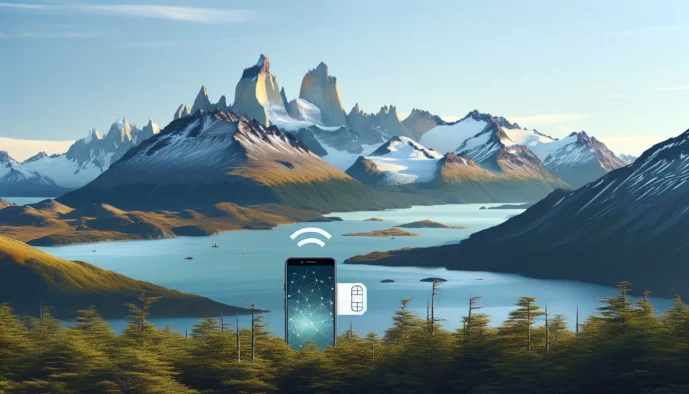Internet, Sim Card and Phone in Patagonia and Tierras del Fuego
Stay connected in Patagonia and Tierra del Fuego with tips on internet access, SIM cards, and phone usage for seamless travel.

Patagonia and Tierra del Fuego, spanning southern Chile and Argentina, are renowned for their breathtaking landscapes and remote wilderness. Staying connected in this region can be challenging due to its vast, sparsely populated areas. Here’s what you need to know about phone coverage, internet access, and staying connected while exploring South Patagonia.
Essentials
Mobile Phone Coverage
- Coverage Overview: Mobile coverage in Patagonia and Tierra del Fuego is limited, especially outside major towns and along remote trails. Coverage is generally better on the Chilean side due to infrastructure investments by providers like Entel, which has the most extensive network in the region.
- Argentine Side: In Argentine Patagonia, Claro, Movistar, and Personal offer coverage in towns like El Calafate, Ushuaia, and Río Gallegos, but service is sparse in rural areas such as El Chaltén.
- Chilean Side: In Chilean Patagonia, Entel, Movistar, and Claro provide coverage in towns like Punta Arenas and Puerto Natales, but expect limited or no service in remote areas like Torres del Paine or Tierra del Fuego.
SIM Cards and Roaming
- Local SIM Cards: Purchasing a local SIM card is recommended for better rates and connectivity. In Argentina foreigners can only buy from Claro. In Chile, opt for Entel.
- Cost: SIM cards cost around 1,000–2,000 ARS in Argentina and 5,000–10,000 CLP in Chile, with additional credit for calls, texts, and data. Consider a 20 Usd plan if you stay one month.
- Cross-Border Use: SIM cards from one country may not work well across the border. If traveling between Argentina and Chile, consider getting a SIM card for each country.
- Roaming: International roaming can be expensive and unreliable in remote areas. Check with your provider for roaming packages, but expect limited coverage.
If you take a tour with us. Your guide will share with you his connections in stops and cafés, when connection is available.
Internet Access
- Wi-Fi: Wi-Fi is available in hotels, hostels, and cafes in towns like El Calafate, Ushuaia, Punta Arenas, and Puerto Natales. However, speeds can be slow, and connections may be unreliable.
- Mobile Data: Mobile data is often more reliable than Wi-Fi, especially in towns. However, data speeds may be slower in remote areas, and coverage is limited outside populated zones.
Internet Speeds
- In towns and cities, internet speeds are decent, with 3G or 4G LTE available. However, in remote areas like Torres del Paine, Tierra del Fuego, or along hiking trails, connectivity is minimal or nonexistent.
- Satellite internet is sometimes used in lodges or remote accommodations, but it can be slow and expensive.
Communication Apps
- Popular messaging and calling apps like WhatsApp, Telegram, and Zoom are widely used in Patagonia and Tierra del Fuego. WhatsApp is particularly dominant for both personal and business communication.
- Download these apps and set them up before your trip, as they can work over Wi-Fi or mobile data when available.
Power and Adapters
- Argentina: Uses Type C and Type I power outlets, with a standard voltage of 220V and a frequency of 50Hz.
- Chile: Uses Type C and Type L power outlets, with a standard voltage of 220V and a frequency of 50Hz.
- Bring a universal adapter and/or voltage converter if your devices use a different plug type or voltage.
- Power outages are rare in towns but can occur in remote areas. Carry a portable charger for your devices.
Practical Tips
- Unlock Your Phone: Ensure your phone is unlocked before traveling so you can use local SIM cards.
- Download Offline Maps: Apps like Google Maps or Maps.me allow you to download maps for offline use, which is essential for navigating remote areas with no connectivity.
- Monitor Data Usage: Keep an eye on your data usage to avoid running out of credit unexpectedly. Most providers offer apps to track usage and top up credit.
- Backup Connectivity: If you’re traveling to extremely remote areas, consider renting a portable Wi-Fi hotspot or satellite phone for emergencies.
Key Towns and Connectivity
- El Calafate (Argentina): Good mobile coverage and Wi-Fi in town, but limited in surrounding areas.
- El Chaltén (Argentina): Very poor mobile coverage and Wi-fi even in town.
- Ushuaia (Argentina): Reliable coverage and Wi-Fi in town, but sparse in Tierra del Fuego National Park.
- Punta Arenas (Chile): Strong mobile coverage and Wi-Fi in town, with decent connectivity along the Strait of Magellan.
- Puerto Natales (Chile): Good coverage in town, but limited in Torres del Paine National Park.
- Torres del Paine (Chile): Minimal to no coverage within the park. Some lodges offer Wi-Fi, but it’s often slow and expensive.